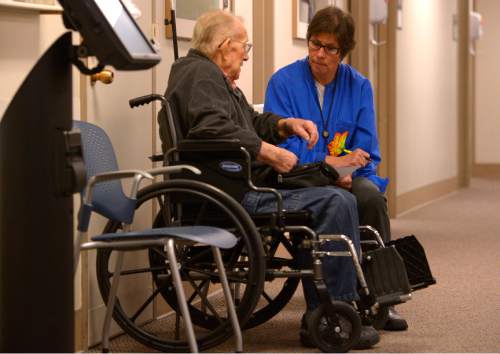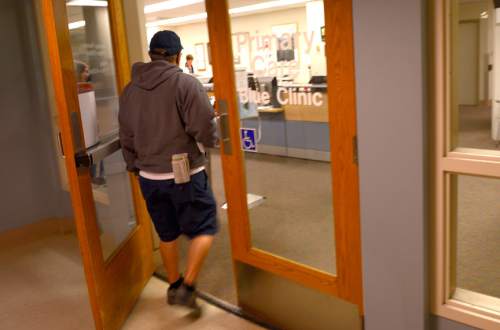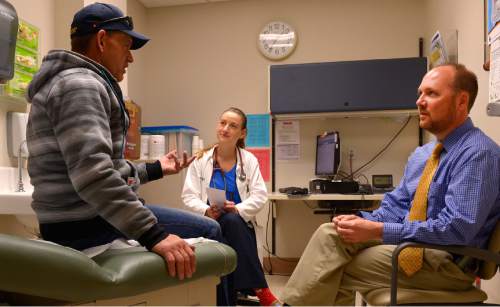This is an archived article that was published on sltrib.com in 2015, and information in the article may be outdated. It is provided only for personal research purposes and may not be reprinted.
Andrew Wilson is a veteran of the Vietnam War and a diabetic.
On March 13, he received a notice that it was time for an annual exam to determine how diabetes is affecting his eyesight. But first, he had to see his primary care physician at a Veterans Affairs clinic in Orem, near his home. A doctor there gave Wilson a checkup and recommended he make an appointment with a podiatrist, too.
"I am actually pretty happy with my service at the Orem clinic," said Wilson, 68.
While Wilson is pleased, military veterans in Utah are among the most likely to wait for appointments at Veterans Affairs medical facilities nationwide. But V.A. staffers here say they believe the addition of more doctors and other changes being made at the George E. Wahlen V.A. Medical Center in Salt Lake City will reduce the delays.
At the Wahlen Medical Center, where the vast majority of Utah veterans seek some form of care, 5.1 percent of appointments from August 2014 through February of this year were delayed for more than 30 days, according to data obtained by The Associated Press.
The AP focused on that time frame because it signaled the start of a revamped effort to calculate the backlog for appointments at V.A. facilities, and the infusion of $16 billion from Congress to improve medical care for veterans. The Wahlen Medical Center serves veterans in Utah, eastern Nevada and southern Idaho.
Of the 150 V.A. medical centers across the country, only 15 posted worst percentages of delayed appointments than the Wahlen Medical Center. And it had only a slightly better ranking than the much-maligned medical center in Phoenix, which was at the center of the V.A. scandal last year.
The Phoenix medical center had 5.68 percent of its appointments taking longer than 30 days to complete, though that medical center completed twice as many appointments as Salt Lake City.
In a conference call last week with The Salt Lake Tribune, Wahlen Medical Center administrators discussed how they are trying to reduce wait times. Last year, more than 200 additional people have been hired to work in the health care system.
Some of those hires have been in the Patient Aligned Care Teams, called PACTs. The teams combine physicians and nurses with clerks, counselors and other staff to provide a variety of care and administrative services to veterans.
Jill Atwood, a spokeswoman for the V.A. in Utah, said three PACTs are being added.
The internal medicine clinic is being moved to the fourth floor so the primary clinic on the main floor can double in size.
"It all boils down to the time it takes to get the resources and the space that we need," said Bart Lee, director of health administration services department at the center.
Nationwide, 2.81 percent of appointments sought at a V.A. medical center were delayed longer than a month. That amounted to 854,821 appointments.
Veterans were less likely to wait for appointments at the eight outpatient clinics in the Salt Lake City V.A. coverage area. Only 3.12 percent of veterans at the clinics waited longer than 30 days. That statistic includes patients at two clinics in eastern Nevada and one in southern Idaho that are part of the Salt Lake City V.A. coverage area.
Among the. clinics, the worst performer was the one in West Valley City, where 9.3 percent of veterans waited longer than 30 days.
Atwood said the West Valley City clinic did not have a physician for some time, but they have one now and are looking for a second. "I have no doubt we can get the West Valley wait times under control," she said.
Nationwide, about half of 1 percent of appointments take longer than 30 days to complete.
After the 2014 scandal over wait times at V.A. medical facilities, Congress gave the V.A. an extra $16 billion. Atwood said the Salt Lake City V.A. system received a little less than $3.5 million.
That money helped with the hiring of the 200 new staff across the Salt Lake system, Atwood said, and is paying for the space expansion.
Congress also created the Choice Program, which allows certain veterans to receive their care from a private doctor. The veteran must live at least 40 miles from a V.A. medical center or clinic or have been waiting longer than 30 days for an appointment. The private doctor must be willing to accept the same rates for payment as provided by Medicare.
Lee said that as of last week, the Salt Lake City system has 685 veterans who have used the Choice Program.
More doctors are accepting the Choice Program every week.
Wilson is set to have his eye exam Thursday at a private clinic authorized by the V.A.
"I think they're doing a pretty good job of getting us in," Wilson said. "The situation has improved so much in the last 10 years, it's like the difference between night and day."
Twitter: @natecarlisle Veterans' medical care in the region
Utah military veterans are among the most likely to wait for medical care at the nation's Veterans Affairs facilities. At the George E. Wahlen Medical Center in Salt Lake City, which serves the vast majority of Utah veterans, about 5 percent of appointments were delayed from August 2014 to February of this year.
Name of facility Appointments completed Care delayed at least 31 days Percent delayed at least 31 days
Wahlen Medical Center 128,103 6,532 5.1%
West Valley City Clinic 5,582 519 9.3%
St. George Clinic 7,178 260 3.62%
Ogden Clinic 10,715 327 3.05%
Orem Clinic 6,400 76 1.19%
Roosevelt VA Clinic 966 7 0.72%
Pocatello, Idaho, Clinic 10,307 173 1.68%
Ely, Nev., Clinic 573 0 0.00%
Elko, Nev., Clinic 487 37 7.6%
Totals 170,311 7,931 4.66%
V.A. medical centers nationally — — 2.81%
V.A. clinics nationally — — 0.52%
Note • The Pocatello, Elko and Ely clinics are part of the Salt Lake City V.A. networkSource: Veterans Administration via AP







